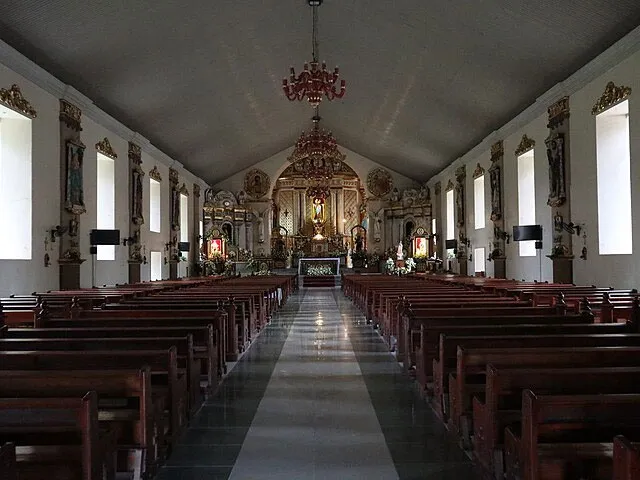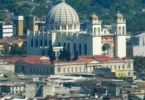
Introduction
The San Joaquin Parish Church (Spanish: Iglesia Parroquial de San Joaquin), commonly known as San Joaquin Church, is a Roman Catholic Church in the municipality of San Joaquin, Iloilo, Philippines within the jurisdiction of the Roman Catholic Archdiocese of Jaro. It is largely known for its pediment featuring a military scene, the Spanish victory over the Moors in the Battle of Tétouan. The church was declared a National Cultural Treasure by the National Museum of the Philippines.
Built during the Spanish era in the late 1800s, the church of San Joaquin in Poblacion has become Iloilo’s symbol of the victory of good over evil. San Joaquin Church was erected with the help of famous sculptors, skilled masons, and celebrated craftsmen and painters from Mexico and Spain. When Friar Thomas Santaren, who was the town’s parish priest at the time of the church’s construction, heard about the victory of the Spanish, he instructed the workers to create a bas-relief version of the Battle of Tetouan. The mural was called Rendicion de Tetuan and shows military scenes between the Spanish army and the Morrocans.
San Joaquin Church was declared a national shrine in September 1977. The militaristic design drew admiration and visitors from all over the country. The church was later proclaimed as one of the Cultural Heritage Churches of the Philippines by the National Historical Institute in November 2001.
The construction of San Joaquin Church was completed in 1869 during the Spanish colonization era by Augustinians. The convent of the San Joaquin Church was left in ruins after the World War II leaving its noted well and kiln which were used for baking. The then National Historical Institute marked the church as a National Historical Site in 1980 pursuant to Presidential Decree No. 260 of 1973 and Presidential Decree No. 375 of 1974. In the 1980s the church structure underwent renovations. The side and back walls and the altar area was reinforced by cement by local priest which according to heritage conservationists caused the loss of the structure’s integrity and authenticity.
The structure was declared a National Cultural Treasure (NCT) by the National Museum of the Philippines (NMP) in 2001. The declaration also covers the convent ruins of the church complex. In 2015, a restoration was accomplished on the church building under the watch of the National Historical Commission of the Philippines but the lime plaster or palitada used to cover the facade chipped off in less than a year which led to heritage conservationists criticizing the national heritage body. Following the declaration of the San Joaquin Campo Santo cemetery as a NCT by the NMP, the heritage organization labels the church complex and the cemetery as the “San Joaquin Church Complex and Campo Santo of San Joaquin, Iloilo”.
Just recently, January 19, 2019, the Parish of San Joaquin celebrated the 150th Anniversary of the Church since 1869, the year the church’s construction was completed during the time of Fray Tomas Santaren, OSA. The parishioners with the priests assigned helped together to re-enhance the interior design of the church and making all ways of restoring the original designs especially of the tabernacle with its gradas and also of the design of the side retablos. All the designs were carefully made so as to reflect the original designs of the church. The church was solemnly dedicated by His Excellency Most Rev. Jose Romeo O. Lazo, DD last January 18, 2019. Adjacent to the church, is the new Adoration Chapel which was blessed on the day of the fiesta celebration last January 19, 2019.

Architecture Style : Baroque
San Joaquin Church occupies a complex that has a vista of the surrounding sea. Among its distinctive sites that are remnants of an old convent are a kiln and a round water well. It is famous for its pediment that is a prominent feature of its facade and famed for portraying in bas relief the Battle of Tetuan in 1861 where the victorious Spaniards fought against the Moroccan army. Its kinetic depiction of military triumph (Spanish forces of cavalry and infantry crushing the Moors) makes it stand out from other colonial churches in the country. In the relief is its title, Rendicion de Tetuan. And on the ridges of the gable is a set of balustrade and five finials.
Below the pediment is a niche flanked by stained glass windows. In the ground level, the entrance is an archway bounded by twin Corinthian columns. These columns are also found in outermost corners. Above the archway is a cartouche in low relief of the Augustinian symbol with two putti. On the entablature one can also find a row of rosettes. A massive bell tower rises in the epistle side of the church’s facade. It is connected to the church at its quadrangular base. The upper two levels are hexagonal in shape pierced with arch openings and capped off with a dome, cupola, and a cross. The church itself does not contain any transepts, thus the nave leads directly to the sanctuary. Buttresses are found along its nave walls.
Heritage
San Joaquin Church was declared a National Historical Landmark, and the National Historical Institute installed a historical marker in 1980. Moreover, the National Historical Commission of the Philippines installed a heritage marker reiterating the church as a National Historical Landmark in 2015. It was later declared a National Cultural Treasure by the National Museum of the Philippines on June 31, 2001, and they installed a heritage marker on August 16, 2016 in time for the foundation day of the town.
Geography
San Joaquin is located in the southern tip of Iloilo Province. One of the rivers that traverse the town is the Siwaragan River with Barangay Siwaragan and Bucaya situated in its mouth. It is the southernmost municipality in the province and is 53 kilometres (33 mi)[5] from the provincial capital, Iloilo City, and is 44 kilometres (27 mi) from San Jose de Buenavista, the capital of Antique.
San Joaquin Cemetery
The San Joaquin Cemetery is located along the main highway in San Joaquin Town. The construction of San Joaquin Cemetery was commenced by Fray Mariano Vamba, the last Augustinian parish priest of the town in 1892. A statue of Jesus with his arms outstretched stands on top of a baroque style gate, and on each side of Christ, two columns with angelic figures are poised as guards. In addition, sculpted heads of two cherubs and a skull representing death marks the entrance of the cemetery. Twenty stone steps after entering the gate and you will be greeted by the Baroque designed mortuary chapel standing on the center.

Campo Santo
San Joaquin Parish is also known for the beautiful, well-preserved Spanish-era cemetery called Campo Santo. It was built by Fr. Mariano Vamba, the last Augustinian parish priest, in 1892. It was declared a National Cultural Treasure in 2015, and its heritage marker was installed by the National Museum of the Philippines on November 1, 2016. Located along the main thoroughfare, this old, grand necropolis is behind a gate that bears ironwork and stone ornaments. Entrance is through a carved stone entryway with arch tracery. Its cornices are richly ornamented, and the pediment has a central semicircle emblem with bands radiating outward into the triangular borderline. On the arch its capstone bears a high relief of a putto flanked by skull symbols. On top of its thick walls are decorative urns, the figure of Christ with outstretched arms, and two figures of angels.
Visitors are let into a paved walkway and a flight of eighteen steps. What then greets the eye is the historic mortuary chapel called capilla built in Baroque tradition, an imposing edifice among silent crypts and the heart of the Campo Santo. It sits on a promontory whose perimeter walls (which one can spy from the staircase) are niches where images of holy figures are enshrined. The capilla is made of red bricks and quarried coral stone, and it is crowned with a red dome and a cross. Inside, one can discover an alcove containing a replica of La Pieta. Motifs of foliage are repeated in many areas of the cemetery complex, such as on pilasters in the archway and apertures in the capilla. Finials are another recurring theme found on the roof of the capilla and the pinnacles of the gate. A balete tree once threatened the integrity of the structure, and people organized a drive to raise money in 2005 to fund for its rehabilitation.
On February 24, 2016, ten people were apprehended for excavating a 60-foot tunnel under the cemetery. The enterprise was motivated by a legend so they embarked on a treasure hunt for gold and precious items. The illegal digging activity left the ground and foundation vulnerable, and the tunnel had since been shut off. Currently, Campo Santo is under the guard of the municipal local government and the parish pastoral council.
Features
The features of note of the church are its three retablos of carved limestone which were formerly polychromed, the carved pediment which featured the folk portrayal of the Spanish winning over the Moors at the Battle near Tétouan, Morocco as well as its adjacent sprawling ruins where an oven well and kilin for baking can be found.
Annual Feast Day
Feast day: 16 August
The annual feast day of The Church of San Joaquin Church Iloilo, Philippines is celebrated on August 16 each year.
Mass Timing
Week Days:
Monday – Friday: 5:30-6:30 AM
Weekend:
Saturday – 5:30-6:30 AM
Sunday – 5:30-6:30 AM, 8:00-9:00 AM (Facebook Live)
4:30-5:30 PM (Children and Youth Mass)
Contact Info
H4PR+CGJ,
San Joaquin,
5024 Iloilo,
Philippines.
Accommodations
Connectivities
Airway
The nearest airport to The Church of San Joaquin Church Iloilo, Philippines is, Evelio B. Javier Airport, QW9M+583, San Jose de Buenavista, Antique, Philippines, which is just 1 hr 13 min (47.0 km) via PC Barracks Rd away from the basilica.
Railway
The nearest railway to The Church of San Joaquin Church Iloilo, Philippines, Old Pavia Train Station, Pavia, Iloilo, Philippines, which is just 1 hr 28 min (56.5 km) via Iloilo – Antique Rd S away from the basilica.








